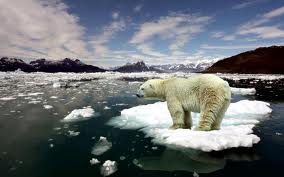Shell to Start Work on Arctic Wells
 Royal Dutch Shell has been given preliminary permission to start drilling in the Arctic, raising hopes that it will be able to complete its two planned exploration wells in the region before the threat of encroaching sea ice makes operations impossible.
Royal Dutch Shell has been given preliminary permission to start drilling in the Arctic, raising hopes that it will be able to complete its two planned exploration wells in the region before the threat of encroaching sea ice makes operations impossible.Ken Salazar, the US interior secretary, said Shell would be allowed to begin work on a well in the Chukchi Sea off the north-west coast of Alaska, as long as it did not drill into any oil-bearing rocks.
The decision, marking the culmination of more than seven years of preparation for Shell, is a significant step forward for a project that offers the potential for discovering huge oil resources but also carries high costs and environmental risks.
Pete Slaiby, the vice-president of Shell Alaska, described the move as “extremely exciting”.
However, he warned that it would still be “very, very difficult” to complete the well in the Chukchi Sea unless Shell was granted an extension on the deadline for stopping drilling set by the government.
The preliminary permit allows Shell to drill down to about 1,400 feet, or about a quarter of the way towards the potential reservoir it is targeting.
Mr Salazar said the company would not be allowed to go any further until it had secured final approvals for the Arctic Challenger, the 300-foot barge converted to carry a containment system for catching oil in the event of a spill. He suggested those approvals could come next week, at the earliest.
“We are holding Shell’s feet to the fire,” Mr Salazar said. “We don’t know whether Shell will be able to complete a well in the Arctic this year.”
Shell, Europe’s largest oil company by market capitalisation, had been negotiating over the preliminary approval with the interior department in recent days as it attempted to make as much progress as possible before this year’s Arctic drilling season ends.
The US authorities have set deadlines of September 24 for the Chukchi Sea and October 31 for the Beaufort Sea, to ensure Shell leaves the area before the ice closes in for the winter.
The company, which has already spent $4.5bn on leases and preparations for drilling, has asked for an extension of those deadlines, but Mr Salazar said it would be “premature even to address the issue today” before the company had been granted any permits to drill into oil-bearing rocks.
The company had originally hoped to drill five Arctic wells this summer, but has been forced to cut that to two.
It is still being delayed by problems with the Arctic Challenger, the first of its kind as an oil spill containment vessel. The US Coast Guard has raised concerns about its safety, including its fire prevention systems and the risk that its equipment would make it vulnerable to capsizing during a storm.
Shell and the Coast Guard had talked about giving the Arctic Challenger its final tests this week, but Mr Salazar said that was “probably four or five days away”.
Meanwhile, Shell will be allowed to start drilling in the Chukchi Sea and do other work including digging out the “mud-line cellar”: a hole about 40 feet deep to hold the blowout preventer, the stack of valves at the top of a well intended to prevent leaks of oil and gas. The administration suggested similar permission could be granted for preliminary work in the Beaufort Sea, although the deadline there is slightly further off.
Mr Salazar said the decision was not politically motivated and was unconnected to the Republican party convention this week. Mitt Romney, the Republican candidate for the presidency, is an advocate of increased oil and gas drilling.
However, Mr Salazar did link the move to President Barack Obama’s “all of the above” energy strategy, insisting that the administration wanted to encourage oil and gas production as much as possible.
Shell welcomed the decision, saying it looked forward to “putting Americans to work, and finding out even more about the oil and gas reserves which are believed to lie under Alaska’s Chukchi Sea.”
Environmental campaigners, who have highlighted the risk of a spill comparable to the 2010 Deepwater Horizon disaster in the Gulf of Mexico, raised concerns about the decision to allow work before the containment system was ready.
Marilyn Heiman, director of the US Arctic programme at the Pew Environment Group, the conservation charity, said: “The biggest lesson we learned from Deepwater Horizon was that you need to have a capping and containment system designed and on site ready to use so you can stop a spill. This is especially important in the remote Arctic.”
You can return to the main Market News page, or press the Back button on your browser.

